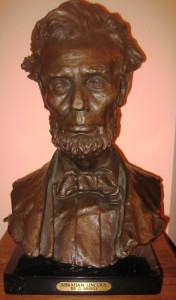 Several times in 1858 Lincoln delivered a lecture he called “Discoveries and Inventions.” Not a particularly successful lecture – the fragments we have remaining suggest it was a bit rambling and lacking in his later eloquence – it presented what was essentially the “American System” of economics based on continuing intellectual and technological improvements.
Several times in 1858 Lincoln delivered a lecture he called “Discoveries and Inventions.” Not a particularly successful lecture – the fragments we have remaining suggest it was a bit rambling and lacking in his later eloquence – it presented what was essentially the “American System” of economics based on continuing intellectual and technological improvements.
In his lecture he notes that man has figured out to substitute for his own brawn other “forces of nature” such as “the power of the wind” and of “running streams.” Lincoln strongly highlights the power of the wind:
“Of all the forces of nature, I should think the wind contains the largest amount of motive power—that is, power to move things. Take any given space of the earth’s surface—for instance, Illinois—- and all the power exerted by all the men, and beasts, and running-water, and steam, over and upon it, shall not equal the one hundredth part of what is exerted by the blowing of the wind over and upon the same space. And yet it has not, so far in the world’s history, become proportionably valuable as a motive power. It is applied extensively, and advantageously, to sail-vessels in navigation. Add to this a few wind-mills, and pumps, and you have about all. That, as yet, no very successful mode of controlling, and directing the wind, has been discovered; and that, naturally, it moves by fits and starts—now so gently as to scarcely stir a leaf, and now so roughly as to level a forest—doubtless have been the insurmountable difficulties. As yet, the wind is an untamed, and unharnessed force; and quite possibly one of the greatest discoveries hereafter to be made, will be the taming, and harnessing of the wind. That the difficulties of controlling this power are very great is quite evident by the fact that they have already been perceived, and struggled with more than three thousand years; for that power was applied to sail-vessels, at least as early as the time of the prophet Isaiah.”
Here is Lincoln fifty years before Nikola Tesla, using much of the same language, referring to motive power and the taming of the power of the wind. He also advocated for the power of running streams as “a motive power,” in particular its “application to mills and other machinery by means of the “water wheel” – a thing now well known, and extensively used.” In fact, Lincoln supposedly invented a water wheel as early as the spring of 1834, long before his lecture on Discoveries and Inventions.
Of course, Lincoln’s water wheel provided mechanical power. We would have to wait a few more decades before Nikola Tesla invented a means for large-scale use of the motion of water to create hydroelectric power, but Lincoln was already anticipating the idea. A few years later in the Civil War Lincoln worked closely with Joseph Henry, who prior to becoming the first Secretary of the Smithsonian Institution had developed the precursors to the induction motor.
Ah, but this wasn’t the first foray into science for Abraham Lincoln. More to come.
[The above is adapted from my e-book, Abraham Lincoln and Nikola Tesla: Connected by Fate, available for download on Amazon.com.]
David J. Kent is an avid science traveler and the author of Lincoln: The Man Who Saved America, in Barnes and Noble stores now. His previous books include Tesla: The Wizard of Electricity and Edison: The Inventor of the Modern World and two specialty e-books: Nikola Tesla: Renewable Energy Ahead of Its Time and Abraham Lincoln and Nikola Tesla: Connected by Fate.
Check out my Goodreads author page. While you’re at it, “Like” my Facebook author page for more updates!










